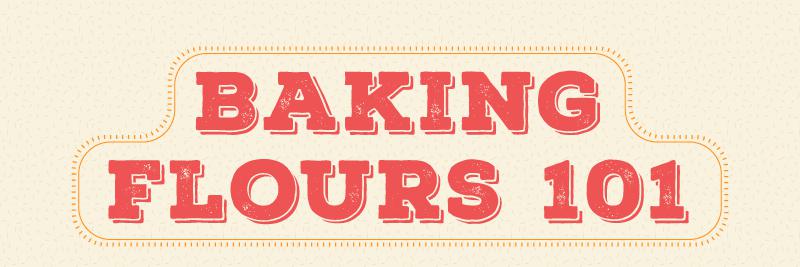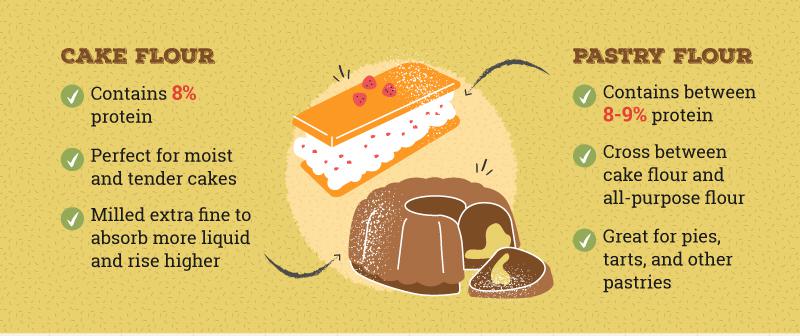
Many people refer to baking as more of a science than an art. That is true in many aspects, but especially when choosing your flour.
Flour is easily one of the most important, if not the most important ingredient in any baking that you will be doing, and there are so many varieties it can be hard to differentiate between them for the best results.At Bobs, we have many different flour types, from all purpose flour to gluten free flour substitutes such as
cassava flour,
almond flour,
coconut flour and more.
The key difference in flours is the amount of protein each contains. The higher the protein level, the sturdier and chewier your end product will be, whereas lower protein levels will yield a flakier result. We have put together a list of some of the most common types of flour that you can use for baking, and how you can best use each one!

All Purpose Flour
Your typical, run-of-the-mill all purpose baking flour contains about 10-12% protein, which is a fairly moderate amount.
All purpose flour is made by separating the three parts of the wheatthe bran, the germ, and the endospermand only grinding the endosperm. Its typically milled from high and low protein wheat, which makes it flexible enough for almost any baking purposeit is sturdy enough to support different types of bread, but not too strong for a tender cookie or brownie. This flour is typically bleached, but you can also purchase the unbleached version as well. We recommend always having a bag of all purpose flour in the pantry for your everyday baking needs!

Whole Wheat Flour
The main difference with
whole wheat flour is that it is made by milling the whole wheatthe bran, the germ, and the endospermnot just the endosperm. This process gives the whole wheat flour a darker color, wheatier taste, and more density. These are the same qualities your baked goods will have if you substitute whole wheat flour. It also has about 13% protein, higher than your all purpose flour. Start by substituting only 25% of your all purpose for whole wheat flour, and work your way up to about 50% if you like.
Self-Rising Flour
This flour is a Southern staple, and most self-rising flour comes from the Southern part of the United States. Self-rising flour is made with softer wheat and has a lower level of protein, 8.5%, which makes it ideal for creating tender and flaky biscuits and muffins. Self rising flour is also a wheat flour and contains
baking powder and a dash of salt already, so you do not have to worry about mixing the extra ingredients!

Cake Flour
At 5-8% protein, cake flour has the lowest protein content and is perfect for creating flaky cakes. Cake flour is milled to an extra-fine consistency, which helps it absorb more water and rise higher, as you want a cake to do. Your cakes will be extra tender if you use cake flour!
Pastry Flour
Pastry flour is a middle man between your all purpose flour and your cake flour, at around 8-9% protein content. It will make your dish tender and flaky, but still maintains the sturdiness you need for things like pies, tarts, and other pastries. You can even make your own version of pastry flour by simply mixing about two parts all purpose flour to one part cake flour.

Bread Flour
Of course, when making yeasted bread, which has a specific shape in mind, a flour with a very high protein content is most desirable. The 12-15% protein in bread flour helps maintain the shape of the bread and reacts with the yeast to help it rise correctly. You can find
bread flour in either white or whole wheat, bleached or unbleached, whatever you prefer.
Whether youre looking for a specific flour or premade
baking mixes that cut your baking time in half, there is a perfect flour out there for you! We even have a variety of
gluten free flours to choose from. We would suggest keeping some all purpose flour in the kitchen in case you decide to bake on a whim, but you can get more specific when you have special projects in mind. Keep our advice in mind and try out your favorite baking recipes for Valentines Day or any day of the week! Check out our article on some
perfect pink Valentines Day cakes here. Let us know your favorite types of flour and baking recipes in the comments below!




 Many people refer to baking as more of a science than an art. That is true in many aspects, but especially when choosing your flour. Flour is easily one of the most important, if not the most important ingredient in any baking that you will be doing, and there are so many varieties it can be hard to differentiate between them for the best results.At Bobs, we have many different flour types, from all purpose flour to gluten free flour substitutes such as cassava flour, almond flour, coconut flour and more.
The key difference in flours is the amount of protein each contains. The higher the protein level, the sturdier and chewier your end product will be, whereas lower protein levels will yield a flakier result. We have put together a list of some of the most common types of flour that you can use for baking, and how you can best use each one!
Many people refer to baking as more of a science than an art. That is true in many aspects, but especially when choosing your flour. Flour is easily one of the most important, if not the most important ingredient in any baking that you will be doing, and there are so many varieties it can be hard to differentiate between them for the best results.At Bobs, we have many different flour types, from all purpose flour to gluten free flour substitutes such as cassava flour, almond flour, coconut flour and more.
The key difference in flours is the amount of protein each contains. The higher the protein level, the sturdier and chewier your end product will be, whereas lower protein levels will yield a flakier result. We have put together a list of some of the most common types of flour that you can use for baking, and how you can best use each one!




